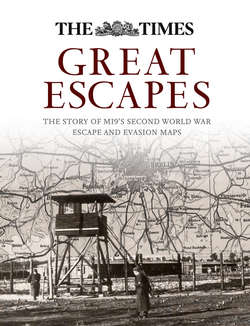Читать книгу Great Escapes: The story of MI9’s Second World War escape and evasion maps - Barbara Bond - Страница 15
3 THE MAP PRODUCTION PROGRAMME
Оглавление‘Geography is about maps . . .’
(Edmund Clerihew Bentley, from Biography for Beginners, 1905)
The detail of MI9’s mapping programme, which became such an important part of their escape programme, has been difficult to piece together. No single, comprehensive record of the production programme has ever been found and only now, in 2015, is a record set of the maps being deposited in The National Archives by the Ministry of Defence. Copies of the maps have been found in many collections, both public and private, throughout the country. There is, however, very little mention of the maps in the published literature and some of the possibly relevant MI9 files in The National Archives are still closed.
Reconstructing the story has proved to be like the reassembly of a jigsaw puzzle where some pieces are still missing, possibly lost for all time. The records that remain make it difficult to describe and record the extent of the programme and the challenges faced in ensuring the quality and utility of the maps for their intended users. It is likely that MI9 kept a card index of the individual maps in the programme in the same way as they are known to have kept a card index to maintain a record of other aspects of their work. Sadly, none of the card indexes appear to have survived and there is, therefore, no comprehensive record of MI9’s escape and evasion map production programme available.
The programme has had to be pieced together from, sometimes, fragmentary information. The single most comprehensive record is undoubtedly the D.Survey war-time print record which was created, managed and kept up-to-date by Survey 2, that part of D.Survey responsible for the management of all operational map production programmes. This card index was originally found as an uncatalogued item in the India Office Library and Records, housed in the British Library. How it came to be held there, rather than in The National Archives where one might reasonably anticipate finding it, is an enigma, but it has now been catalogued by the British Library.
The second source is a typed list held in one of the War Office files. There is also a third source, a list deposited in the British Library by the archivist of John Waddington Ltd, the Leeds company that printed many of the maps, referred to as ‘pictures’ in their list and in their dealings with the Ministry of Supply. Intriguingly, the typed War Office list also refers to the maps as ‘pictures’, and it is, therefore, likely that it had its origins in the Waddington list.
A selection of escape and evasion maps produced by MI9.
The contents of the three sources are similar but by no means identical. Some of the differences can be explained by apparent human error (misreading of sheet numbers and typographic errors, for example). However, the War Office typed list contains other differences which are less understandable: for example, it states that twenty-nine sheets were produced in a series of maps of Norway, identified by the designation GSGS 4090, whereas the print card index indicates that the series consisted of thirty-three sheets, which proved to be correct since surviving copies of all thirty-three sheets have been identified.
While the print records were originally classified SECRET, some of the detail of the programme was apparently regarded as so sensitive that it was not declared openly even on that classified record. For example, it took some time to confirm, through seeing surviving copies, that the description of one map as ‘D - - - - G’ was a large-scale plan of the port of Danzig and that ‘Dutch Girl’, in four sheets, referred to Arnhem. Other entries on the record remain a mystery: for example, ‘Double Eagle’, although it might reasonably be conjectured that it was a map of Germany and Austria. Indeed, one of the earliest maps produced by MI9 was a small-scale map of Germany, Austria and adjacent frontier areas: it carried the sheet number A, probably indicating that it was the first sheet to be produced. No direct evidence has yet been unearthed, however, to confirm that this is the map which the record describes as ‘Double Eagle’.
Sheet A showing Germany and Austria at 1:2,000,000 scale, one of MI9’s earliest silk maps, which used Bartholomew mapping. It may be the map referred to as ‘Double Eagle’ in the War Office print records.
Where copies of individual sheets (either singly or in combination) survive, it has proved possible to identify the particular print medium, i.e. tissue (a very fine paper), silk or man-made fibre (MMF), almost always rayon but sometimes referred to as Bemberg silk. In some cases it has proved possible to be more precise. The Waddington list, for example, indicates that some of the maps were printed on Mulberry Leaf (ML) paper or Mulberry Leaf Substitute (MLS). Appendices 1–9 record the details of all the maps so far identified using these sources, including coverage, scale, dimensions, production details such as colour, print quantities and combinations, print medium, print dates and location of surviving copies.
